From Subsistence Agro-Pastoral Farming to Tourism-Driven Land Transitions in Ladakh, India
Abstract
1. Introduction
- How have land cover and land use patterns changed over the past four decades in Ladakh’s capital Leh, a major tourism hub, compared with the more remote secondary town of Diskit?
- In what ways have rural–urban transformation and tourism-driven modernization influenced livelihood strategies and the mix of traditional and new income sources in these two contrasting locations?
2. Materials and Methods
2.1. Study Area
2.2. Land Use Change from the 1970s to 2019
2.3. Household Survey
2.4. Survey Data Analysis
3. Results and Discussion
3.1. Same Urbanization Trend but Different Spatial Allocation of Land in Leh and Diskit
3.2. Transformation and Spatial Allocation of Land Strongly Dependent on Local Preferences and Socio-Economic Conditions
3.3. Agricultural Practices Reconcile Local Constraints with New Opportunities
3.4. Importance of Downscaling in Land Allocation Assessment and Its Driving Factors: Implications for Further Research
4. Conclusions
Author Contributions
Funding
Informed Consent Statement
Data Availability Statement
Acknowledgments
Conflicts of Interest
Abbreviations
| LU | Land Use |
| L | Leh |
| D | Diskit |
Appendix A
| Category | Leh (L) | Diskit (D) | Main Difference |
|---|---|---|---|
| Average arable land/HH | 0.85 ha ± 0.86 | 2.01 ha ± 1.79 | Diskit farms are more than twice as large as farms in Leh. |
| Actively cultivated land | 0.35 ha ± 0.51 | 0.58 ha ± 0.44 | Diskit cultivates more area. |
| Pasture area | 0.19 ha ± 1.16 | 0.98 ha ± 0.27 | Diskit uses far more land as pasture. |
| Change in managed land (past 20 yrs) | 33/38 HH reported decrease | 32/40 HH reported decrease | Decrease common in both. |
| Main reasons for practicing agriculture | Income generation (39%), Food production (34%), Tradition (16%), No alternative (11%) | Food production (35%), Income (28%), Tradition (30%), No alternative (7%) | Leh focuses more on income, Diskit more on tradition. |
| Main crops grown | Barley 18%, Wheat 17%, Vegetables 43%, Fruit trees 22% | Barley 29%, Wheat 15%, Vegetables 38%, Fruit trees 19% | Barley more in Diskit, vegetables slightly more in Leh. |
| Most important crop (self-reported) | Vegetables—68% of HH | Vegetables—58% of HH | Vegetables more important in Leh. |
| Adults in agriculture per HH | 3.6 ± 1.1 | 2.9 ± 1.3 | More agricultural labour available in Leh. |
| Hours per person/month in agriculture | 88 ± 62.7 | 83 ± 66.7 | Slightly higher labour input in Leh. |
| Top cropping activities | Weeding vegetables (26%), Ploughing cereals (25%), Flood irrigation (21%) | Cereal harvest (30%), Ploughing (21%), Irrigation (12%) | Focus on vegetables in Leh, cereals in Diskit. |
| HH hiring labour | 31 HH; 6.3 ± 4.8 persons; 5.3 ± 6.1 days/year | 24 HH; 4.6 ± 2.6 persons; 2.6 ± 5.3 days/year | Leh hires more farm workers for longer periods. |
| Fertilizer use | 13 HH use mineral fertilizers; pesticides in vegetables, herbicides in wheat/barley (1 HH) | 7 HH use mineral fertilizers; pesticides in vegetables, herbicides in wheat/barley (10 HH) | Herbicide use far higher in Diskit than in Leh. |
| Irrigation sources | River water pump 37%, Glacier melt water streams 47%, Borehole + mix 16% | River water pump 50%, Glacier melt water 30%, Borehole + mix 20% | More river water pumping in Diskit, more glacier water use in Leh. |
| Change in water availability | 39% pump more groundwater than formerly; 53% report no changes | Only 1 HH pumps more water than formerly; 75% report no changes | Groundwater pumping concerns are much higher in Leh. |
| Crop sales | 20 HH sell crops, with vegetables as main commodity; 49% HH market 26–50% of their harvest; 22% market 76–100% | 26 HH sell crops, with vegetables main commodity; 13% HH market 26–50% of harvest; 71% market 76–100% | Diskit sells a higher share of the vegetable harvest than Leh. |
| Sales outlets | Local market 50%, Army 36%, Hotels/restaurants 14% | Local market 60%, Army 23%, Hotels/restaurants 13% | Local markets more important in Diskit, army sales more important in Leh. |
| Variable | Leh | Diskit |
|---|---|---|
| Adult HH members (n) | 4.0 ± 1.17 | 3.7 ± 1.29 |
| Female HH members (%) | 47.9 ± 18.46 | 45.2 ± 13.98 |
| Age of HH head (years) | 63.2 ± 13.20 | 53.5 ± 16.10 |
| Average age of adult HH members (years) | 48.6 ± 8.80 | 45.7 ± 10.53 |
| Members with formal education (%) | 86.3 ± 15.31 | 72.6 ± 23.51 |
| HH keeping livestock (2019) | 28 of 38 | All HH |
| HH keeping livestock (1999) | 26 of 38 | 18 of 40 |
| Small ruminant keepers (1999 → 2019) | 73% → 25% | 72% → 23% |
| Equine keepers (1999 → 2019) | 69% → 39% | 61% → 35% |
| Main past problem | Predation (16%), fodder shortage (8%) | Predation (38%) |
| Main present problem | Labour shortage (29%), predation (16%), fodder shortage (13%) | Labour shortage (38%), predation (18%) |
| Future main concern | Labour shortage (56%), cultural change (56%) | Labour shortage (58%), cultural change (58%) |
References
- Fastner, K.; Djibrilla, S.; Nguyen, T.; Buerkert, A. Telecoupled Urban Demand from West African Cities Causes Social-Ecological Land Use Transformation in Saharan Oases. PLoS ONE 2023, 18, e0289694. [Google Scholar] [CrossRef] [PubMed]
- Dolma, Y. Tourism in Ladakh: Trends, Opportunities and Challenges. Int. J. Sci. Eng. Res. 2019, 10, 979–986. [Google Scholar]
- Dame, J.; Schmidt, S.; Müller, J.; Nüsser, M. Urbanisation and Socio-Ecological Challenges in High Mountain Towns: Insights from Leh (Ladakh), India. Landsc. Urban Plan. 2019, 189, 189–199. [Google Scholar] [CrossRef]
- Ministry of Law and Justice (Legislative Department). The Farmers’ Produce Trade and Commerce (Promotion and Facilitation) Act, 2020; Gazette of India: New Delhi, India, 2020; CG-DL-E-27092020-222039.
- Singh, J.S. Sustainable Development of the Indian Himalayan Region: Linking Ecological and Economic Concerns. Curr. Sci. 2006, 90, 784–788. [Google Scholar]
- KC, K.B.; Tzadok, E.; Pant, L. Himalayan Ecosystem Services and Climate Change Driven Agricultural Frontiers: A Scoping Review. Discov. Sustain. 2022, 3, 35. [Google Scholar] [CrossRef]
- Bhasin, V. Pastoralists of Himalayas. J. Biodivers. 2013, 4, 83–113. [Google Scholar] [CrossRef]
- Bhasin, V. Ecology and Health: A Study Among Tribals of Ladakh. Stud. Tribes Tribals 2005, 3, 1–13. [Google Scholar] [CrossRef]
- Bhasin, M. Cold Desert: Ladakh. Ecology and Development; Kamla-Raj Enterprises: Delhi, India, 2020. [Google Scholar]
- Bhattacharyya, A. Vegetation and Climate during the Last 30,000 Years in Ladakh. Palaeogeogr. Palaeoclimatol. Palaeoecol. 1989, 73, 25–38. [Google Scholar] [CrossRef]
- Thayyen, R.J. Hydrology of the Cold-Arid Himalaya. In Himalayan Weather and Climate and their Impact on the Environment; Dimri, A.P., Bookhagen, B., Stoffel, M., Yasunari, T., Eds.; Springer International Publishing: Cham, Switzerland, 2020; pp. 399–417. ISBN 978-3-030-29684-1. [Google Scholar]
- Fisher, M.W.; Rose, L.E.; Huttenback, R.A. Himalayan Battleground: Sino-Indian Rivalry in Ladakh; Library of Congress Catalog Card Number: 63-11121; Frederick A. Praeger: New York, NY, USA; London, UK, 1963. [Google Scholar]
- Aggarwal, R. Beyond Lines of Control: Performance and Politics on the Disputed Borders of Ladakh, India; Duke University Press: Durham, NC, USA, 2004; ISBN 978-0-8223-3428-6. [Google Scholar]
- Jina, P.S. Ladakh. The Land and the People; Indus Publishing Company: New Delhi, India, 1996. [Google Scholar]
- Dolma, Y. Impact of Tourism on the Economy of Ladakh Region of the Jammu and Kashmir State of India. Ph.D. Thesis, Department of Economics, Panjab University, Chandigarh, India, 2020. [Google Scholar]
- Ahuja, A.; Kapur, D. Internal Security in India: Violence, Order, and the State; online edn.; Oxford Academic: New York, NY, USA, 2023. [Google Scholar]
- Bhatnagar, Y.; Wangchuk, R.; Mishra, C. Decline of the Tibetan Gazelle Procapra Picticaudata in Ladakh, India. Oryx 2006, 40, 229–232. [Google Scholar] [CrossRef]
- Bhatnagar, Y.V.; Wangchuk, R.; Prins, H.H.T.; Van Wieren, S.E.; Mishra, C. Perceived Conflicts between Pastoralism and Conservation of the Kiang Equus Kiang in the Ladakh Trans-Himalaya, India. Environ. Manag. 2006, 38, 934–941. [Google Scholar] [CrossRef]
- Goodall, S. Changpa Nomadic Pastoralists: Differing Responses to Change in Ladakh, North-West India. Nomadic Peoples 2004, 8, 191–199. [Google Scholar] [CrossRef]
- Thiksay, T.N. To analyze the tourism industry of India with special reference to Leh District of Ladakh Union Territory. Int. J. Dev. Res. 2020, 10, 34472–34477. [Google Scholar] [CrossRef]
- Radhu, S. A Study on The Socio-Economic Impacts of Eco Tourism in Ladakh, India. Int. J. Multidiscip. Res. 2023, 5, 1–9. [Google Scholar]
- Smanla, T. Ecotourism in Ladakh: A Critical Aspect to Contemplate. Int. J. Res. Publ. Rev. 2022, 3, 2096–2105. [Google Scholar]
- Harrison, B. The Impact of a Tourism Boom in an Environmentally-Sensitive Region: A Case Study of Ladakh (Kashmir, India). Jpn. J. Policy Cult. 2021, 29, 21–41. [Google Scholar]
- Lone, I.U.; Mishra, M.; Tiwary, S.K.; Chandra, R. Recognition of Shyok Ophiolites of NW Ladakh Trans-Himalaya as a Geoheritage: Importance to Himalayan Orogeny and Remnant of Tethyan Oceanic Lithosphere. Geoheritage 2022, 15, 3. [Google Scholar] [CrossRef]
- Lillesand, T.M.; Kiefer, R.W. Remote Sens Ing and Image Interpretation, 4th ed.; Wiley: New York, NY, USA, 2000. [Google Scholar]
- Woodcock, C.E.; Loveland, T.R.; Herold, M.; Bauer, M.E. Transitioning from Change Detection to Monitoring with Remote Sensing: A Paradigm Shift. Remote Sens. Environ. 2020, 238, 111558. [Google Scholar] [CrossRef]
- Goodman, L. Snowball Sampling. Ann. Math. Stat. 1961, 32, 148–170. [Google Scholar] [CrossRef]
- US Census Bureau Census and Survey Processing System (CSPro) 2020; United States Census Bureau: Sutland, MD, USA, 2020.
- Statistical Handbook 2017; District Statistics and Evaluation Office: Kargil, Ladakh, India, 2017. Available online: https://dseokargil.ladakh.gov.in/statshandbook.html (accessed on 14 October 2025).
- Stern, R.; Coe, R.; Allan, E.; Dale, D. Good Statistical Practice for Natural Resources Research; CABI publishing: Wallingford, UK, 2004; ISBN 0-85199-722-8. [Google Scholar]
- Dolker, P. An Overview of Transition in Traditional Agriculture of Ladakh. J. Himal. Ecol. Sustain. Dev. 2018, 13, 26–48. [Google Scholar]
- Dollfus, P. Transformation Processes in Nomadic Pastoralism in Ladakh. Himalaya J. Assoc. Nepal Himal. Stud. 2012, 32, 61–72. [Google Scholar]
- Nüsser, M.; Schmidt, S.; Dame, J. Irrigation and Development in the Upper Indus Basin Characteristics and Recent Changes of a Socio-Hydrological System in Central Ladakh, India. Mt. Res. Dev. 2012, 32, 51–61. [Google Scholar] [CrossRef]
- Government of Jammu and Kashmir Statistical Handbook No. 38, 2016–2017; Ladakh Autonomous Hill Development Council: Leh, India, 2017.
- Dame, J.; Nüsser, M. Food Security in High Mountain Regions: Agricultural Production and the Impact of Food Subsidies in Ladakh, Northern India. Food Secur. 2011, 3, 179–194. [Google Scholar] [CrossRef]
- Köster, M.; Alam, I.; Rana, J.; Wiehle, M.; Buerkert, A. A Stony Track towards Innovation in Remote Highland Regions: Agricultural Intensification in the Apricot Sector of Northern Pakistan. Agric. Food Secur. 2024, 13, 27. [Google Scholar] [CrossRef]
- Hirata, M. Milk Culture of South Asia. In Milk Culture in Eurasia: Constructing a Hypothesis of Monogenesis–Bipolarization; Hirata, M., Ed.; Springer: Singapore, 2020; pp. 73–106. ISBN 978-981-15-1765-5. [Google Scholar]
- Dar, S.N.; Shah, S.A.; Wani, M.A. Geospatial Tourist Information System for Promoting Tourism in Trans-Himalayas: A Study of Leh Ladakh India. GeoJournal 2022, 87, 3249–3263. [Google Scholar] [CrossRef]
- Chaudhary, S.; Wang, Y.; Dixit, A.M.; Khanal, N.R.; Xu, P.; Fu, B.; Yan, K.; Liu, Q.; Lu, Y.; Li, M. A Synopsis of Farmland Abandonment and Its Driving Factors in Nepal. Land 2020, 9, 84. [Google Scholar] [CrossRef]
- Namgail, T.; Van Wieren, S.E.; Prins, H.H.T. Pashmina Production and Socio-Economic Changes in the Indian Changthang: Implications for Natural Resource Management. Nat. Resour. Forum 2010, 34, 222–230. [Google Scholar] [CrossRef]
- Buerkert, A.; Luedeling, E.; Dickhoefer, U.; Lohrer, K.; Mershen, B.; Schaeper, W.; Nagieb, M.; Schlecht, E. Prospects of Mountain Ecotourism in Oman: The Example of As Sawjarah on Al Jabal al Akhdar. J. Ecotourism 2010, 9, 104–116. [Google Scholar] [CrossRef]
- Donohoe, H. Defining Culturally Sensitive Ecotourism: A Delphi Consensus. Curr. Issues Tour. 2011, 14, 27–45. [Google Scholar] [CrossRef]
- Turner, B.L.; Lambin, E.F.; Reenberg, A. The Emergence of Land Change Science for Global Environmental Change and Sustainability. Proc. Natl. Acad. Sci. USA 2007, 104, 20666–20671. [Google Scholar] [CrossRef]
- Boehnke, D.; Krehl, A.; Mörmann, K.; Volk, R.; Lützkendorf, T.; Naber, E.; Becker, R.; Norra, S. Mapping Urban Green and Its Ecosystem Services at Microscale—A Methodological Approach for Climate Adaptation and Biodiversity. Sustainability 2022, 14, 9029. [Google Scholar] [CrossRef]
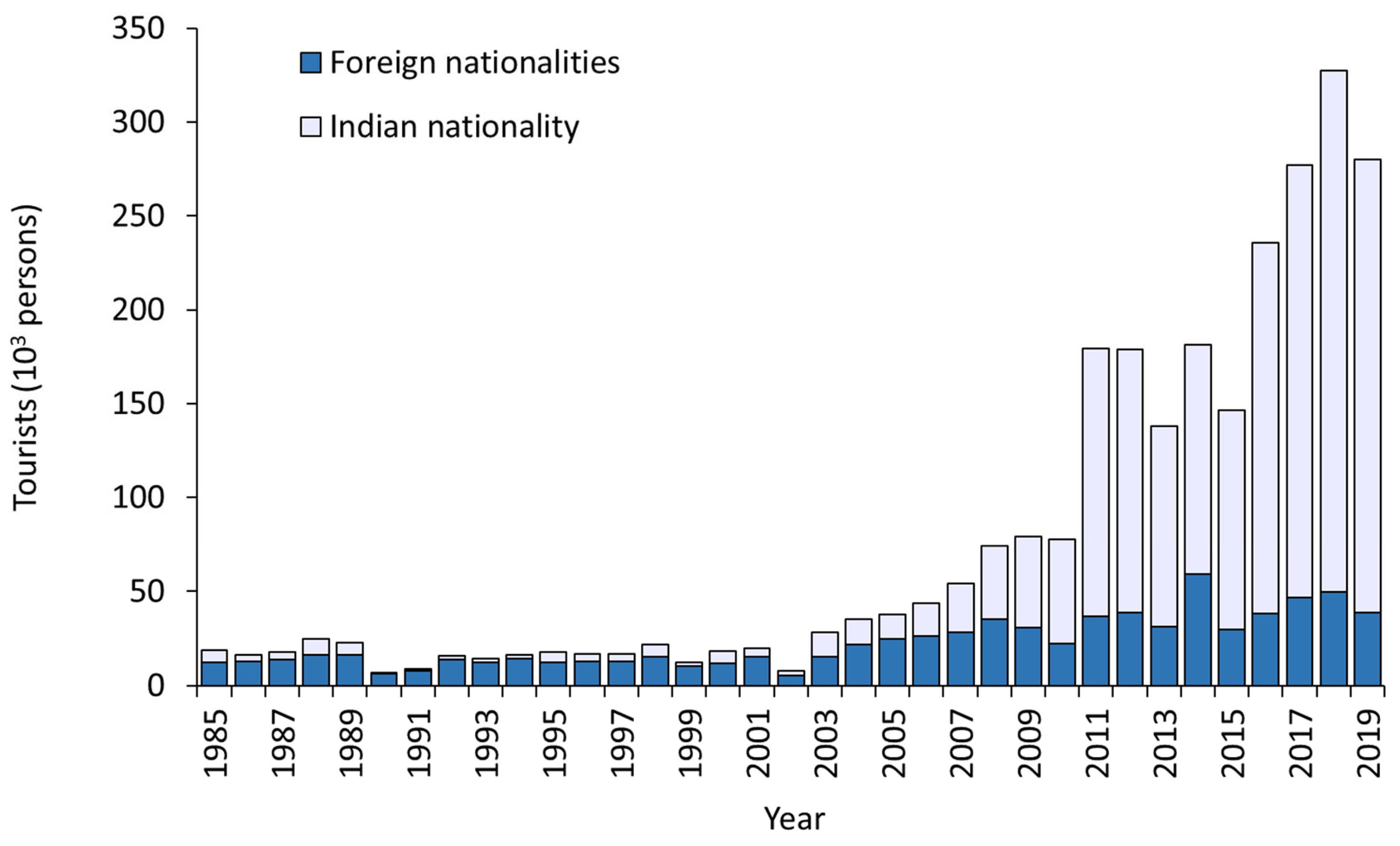
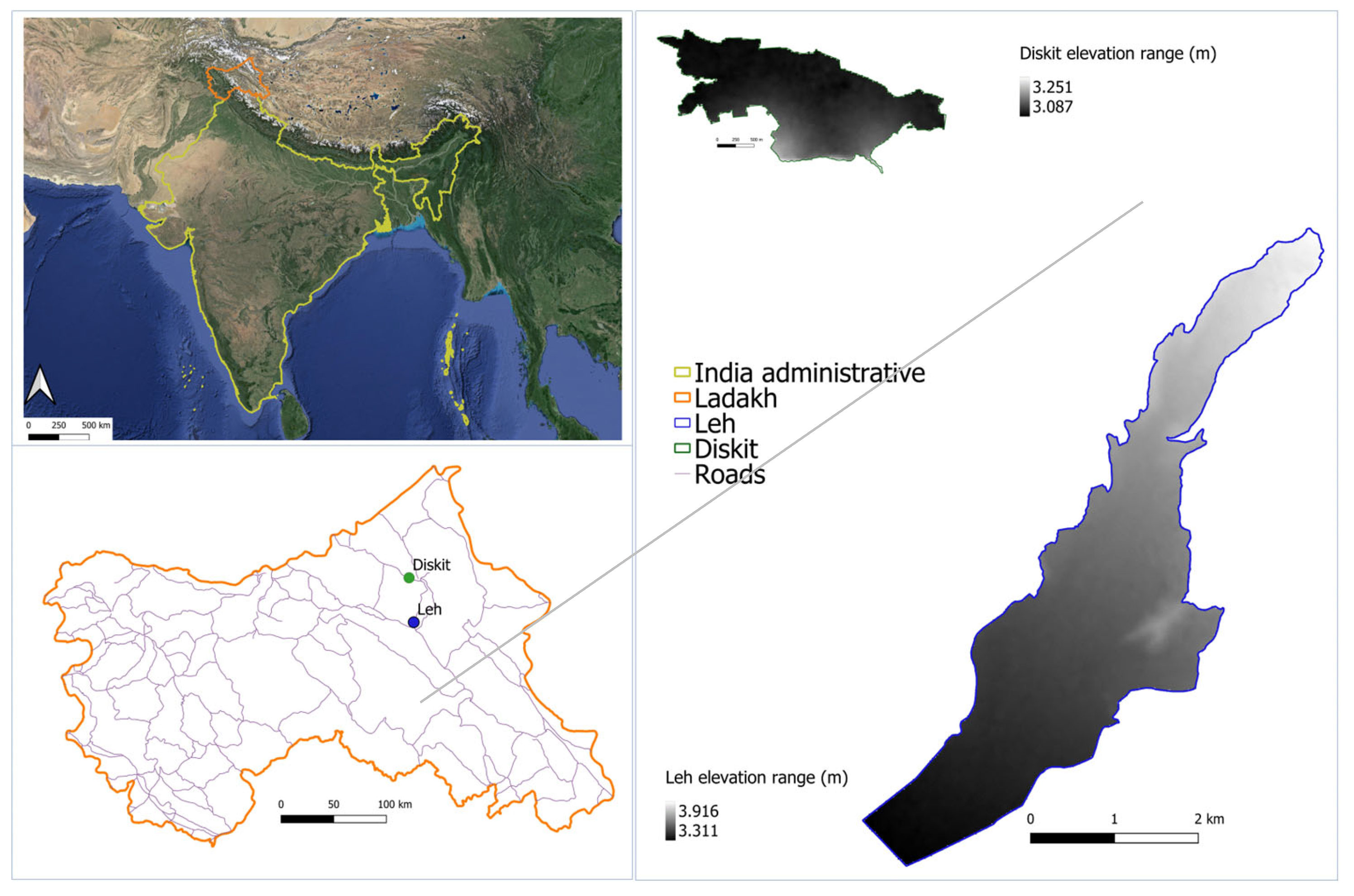
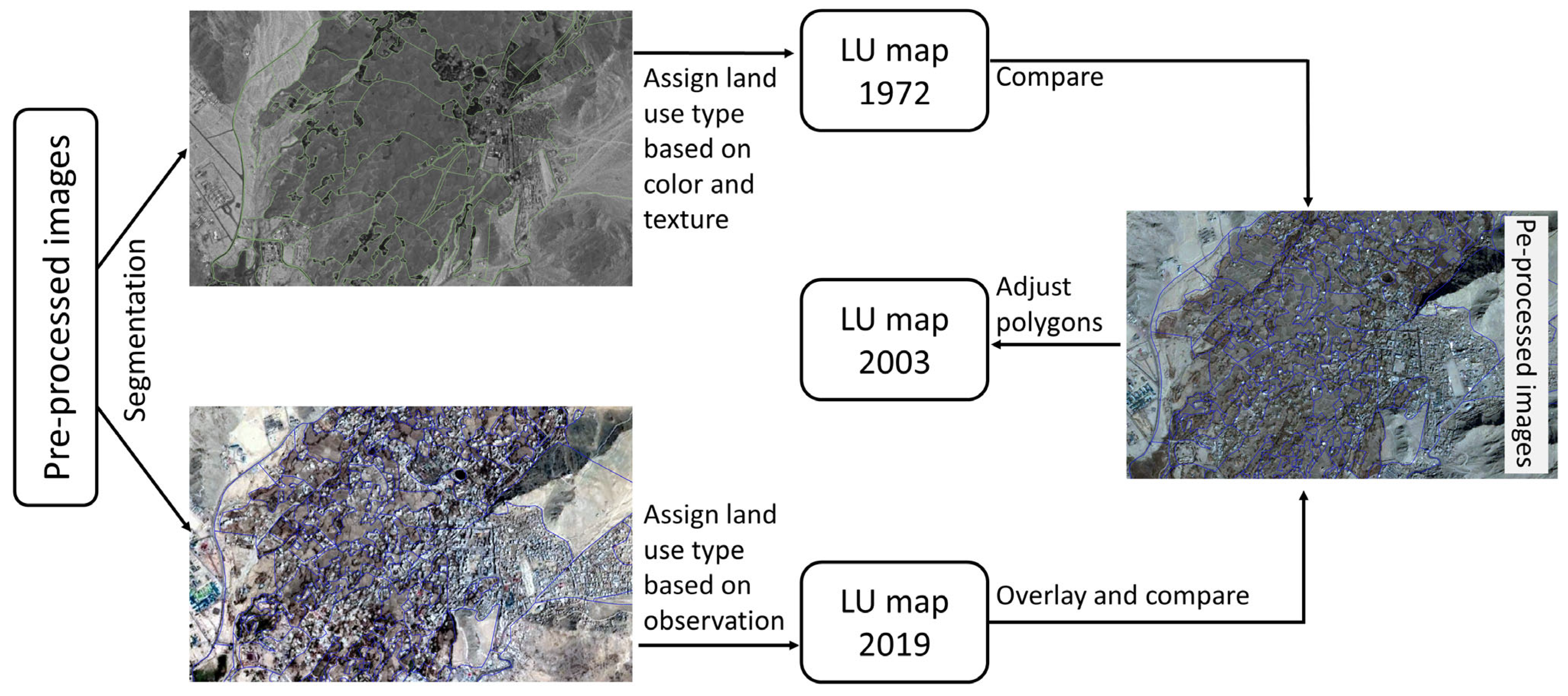
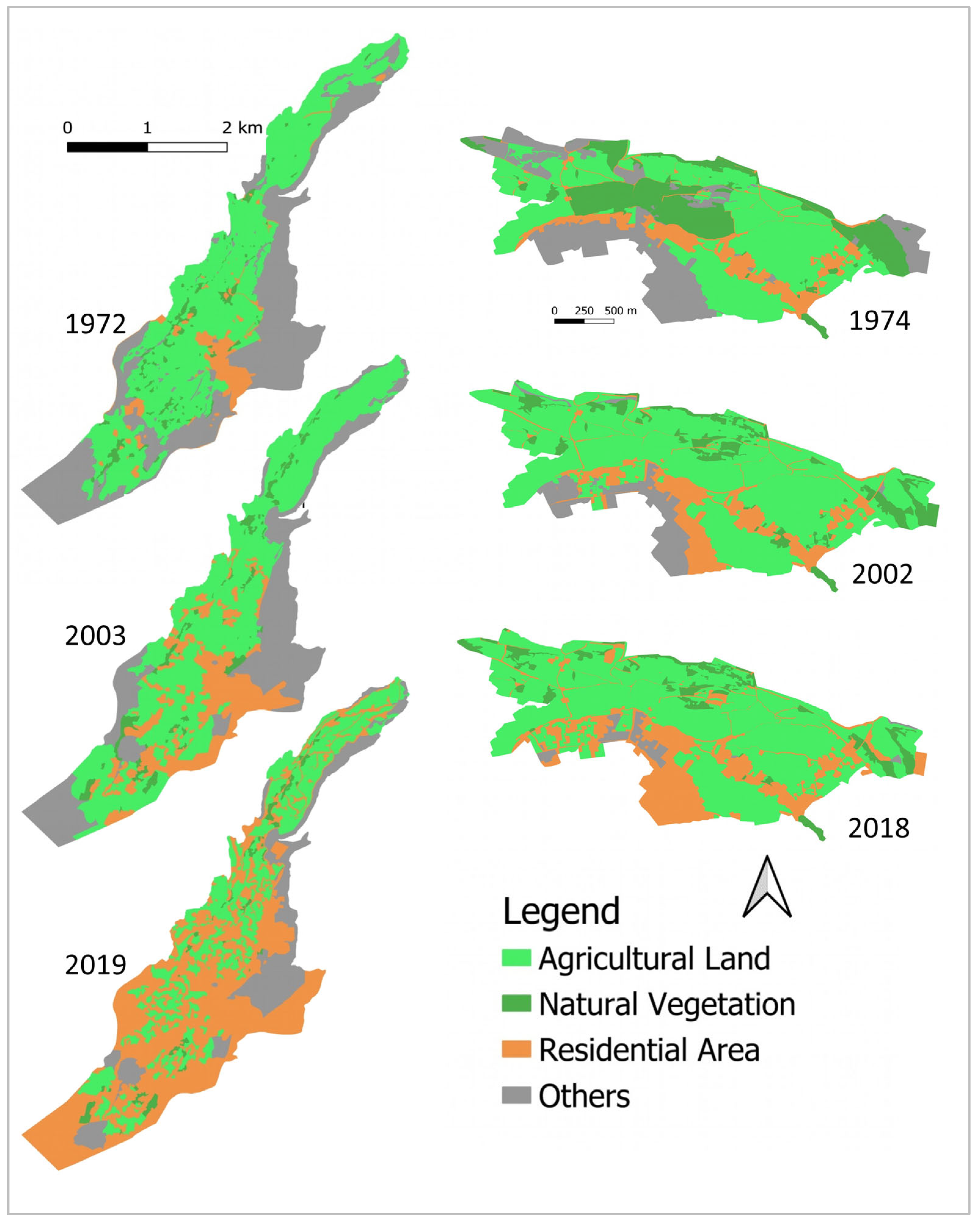

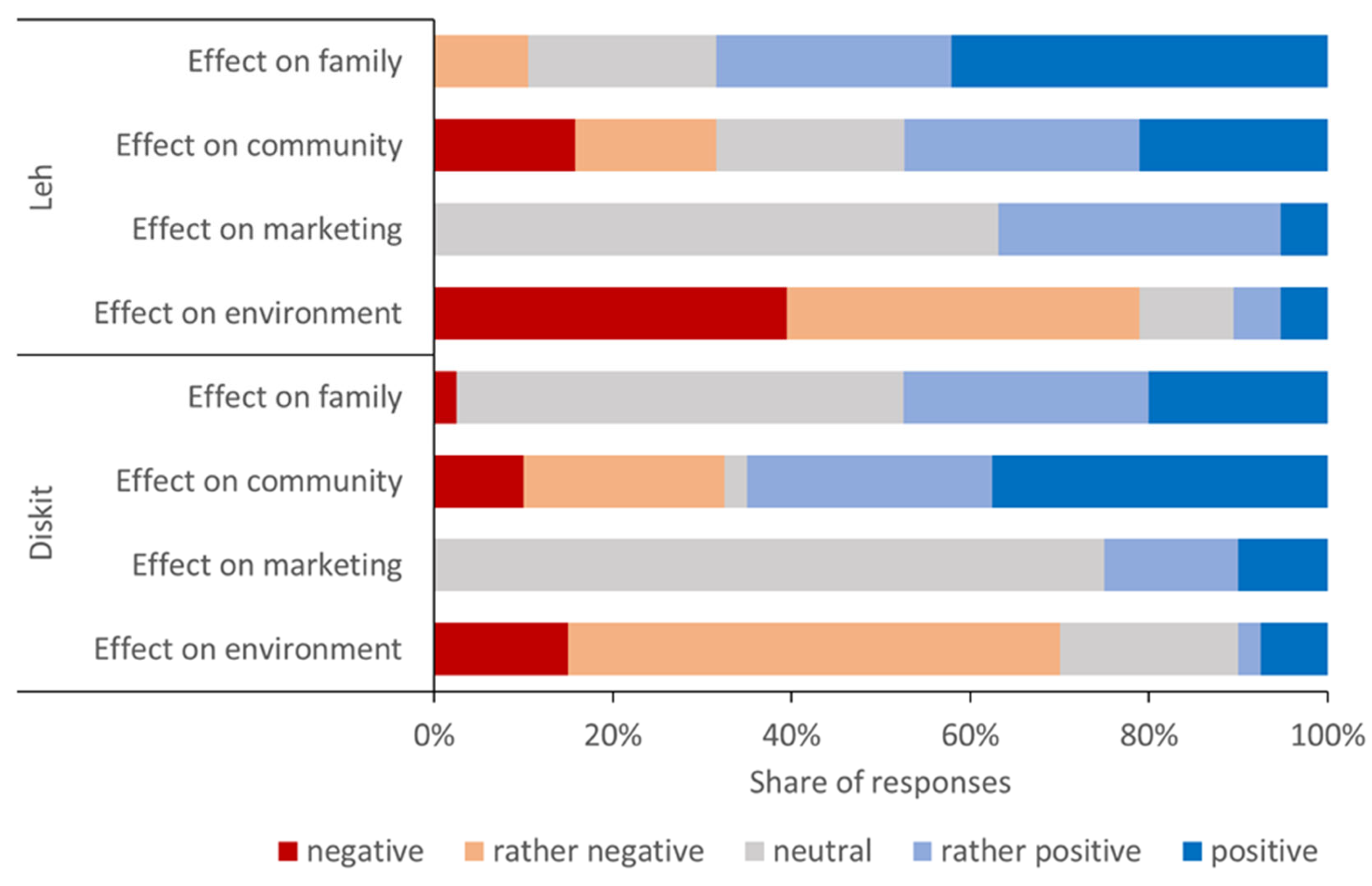

| Images | Study Area | Date of Acquisition | Resolution (m) | Image Type |
|---|---|---|---|---|
| Corona 1972/1974 | Diskit | 16 Nov 1974 | 6 | Panchromatic |
| Leh | 31 May 1972 | 2 | Panchromatic | |
| Google Earth Pro 7.1 2002/2003 | Diskit | 24 Jan 2002 | 1–4 1–4 | True colour (RGB) |
| Leh | 07 Nov 2003 | True colour (RGB) | ||
| Google Earth Pro 7.1 2018/2019 | Diskit | 30 Nov 2018 | 1–4 1–4 | True colour (RGB) |
| Leh | 03 Apr 2019 | True colour (RGB) |
| Nr. | Class | Description | True Colour Google Earth Images in 2019 | Black and White Corona Images in 1972 |
|---|---|---|---|---|
| 1 | Residential Area (Urban) | Housing, roads, and concreted infrastructure such as parking lots, yards, and tennis courts indicated by bright colour and bloc features |  | 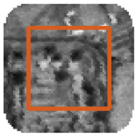 |
| 2 | Natural Vegetation | Forest, shrubs, and dense tree plantations with closed canopy or almost closed canopy |  |  |
| 3 | Agricultural Land | Cropland and grassland with thepossibility of green spaces and/or patches formed by plot boundaries |  | 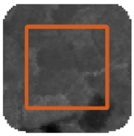 |
| 4 | Others | Water, bare soil, rock, and non-defined/non-recognizable objects (such as those obscured by cloud cover) |  | 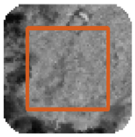 |
| Location, Year | Agricultural Land | Residential Area | Natural Vegetation | Others | Total |
|---|---|---|---|---|---|
| (%) | (%) | (%) | (%) | (ha) | |
| Leh | |||||
| 1972 | 50.6 | 6.6 | 3.4 | 39.2 | 1046 |
| 2003 | 49.4 | 17.3 | 4.2 | 29.0 | 1046 |
| 2019 | 29.2 | 51.6 | 2.7 | 16.3 | 1046 |
| Diskit | |||||
| 1974 | 43.6 | 12.3 | 19.7 | 24.4 | 373 |
| 2002 | 65.7 | 15.9 | 9.2 | 9.0 | 373 |
| 2018 | 65.2 | 24.6 | 7.5 | 2.7 | 373 |
| Income Source | Leh (n = 78 Responses) % | Diskit (n = 73 Responses) % |
|---|---|---|
| Regular off-farm occupation | 51.0 | 49.0 |
| Agriculture (income-earning) | 47.0 | 46.0 |
| Government jobs | 22.0 | 17.0 |
| Tourism sector | 9.0 | 2.0 |
| Private business | 7.0 | 4.0 |
| Army | 1.3 | 7.3 |
| Own shop | 1.3 | 5.3 |
| Pension | 5.3 | 6.0 |
Disclaimer/Publisher’s Note: The statements, opinions and data contained in all publications are solely those of the individual author(s) and contributor(s) and not of MDPI and/or the editor(s). MDPI and/or the editor(s) disclaim responsibility for any injury to people or property resulting from any ideas, methods, instructions or products referred to in the content. |
© 2025 by the authors. Licensee MDPI, Basel, Switzerland. This article is an open access article distributed under the terms and conditions of the Creative Commons Attribution (CC BY) license (https://creativecommons.org/licenses/by/4.0/).
Share and Cite
Buerkert, A.; Ibing, M.; Nguyen, T.T.; Wiehle, M.; Hellwig, I.; Ganeshaiah, K.N.; Schlecht, E. From Subsistence Agro-Pastoral Farming to Tourism-Driven Land Transitions in Ladakh, India. Land 2025, 14, 2120. https://doi.org/10.3390/land14112120
Buerkert A, Ibing M, Nguyen TT, Wiehle M, Hellwig I, Ganeshaiah KN, Schlecht E. From Subsistence Agro-Pastoral Farming to Tourism-Driven Land Transitions in Ladakh, India. Land. 2025; 14(11):2120. https://doi.org/10.3390/land14112120
Chicago/Turabian StyleBuerkert, Andreas, Maximilian Ibing, Thanh Thi Nguyen, Martin Wiehle, Imke Hellwig, Kotiganahalli Narayanagowda Ganeshaiah, and Eva Schlecht. 2025. "From Subsistence Agro-Pastoral Farming to Tourism-Driven Land Transitions in Ladakh, India" Land 14, no. 11: 2120. https://doi.org/10.3390/land14112120
APA StyleBuerkert, A., Ibing, M., Nguyen, T. T., Wiehle, M., Hellwig, I., Ganeshaiah, K. N., & Schlecht, E. (2025). From Subsistence Agro-Pastoral Farming to Tourism-Driven Land Transitions in Ladakh, India. Land, 14(11), 2120. https://doi.org/10.3390/land14112120








